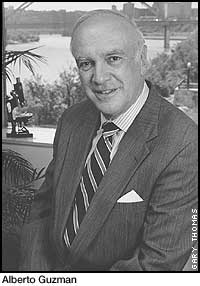|
|
||
|
|
|
 "The Best of CMRI," Alberto Guzman, Announces Retirement
"The Best of CMRI," Alberto Guzman, Announces Retirement
After more than 30 years of developing applied and advanced technologies for many industries, Alberto Guzman, associate director of the Carnegie Mellon Research Institute (CMRI), will retire on June 30.
Guzman is known in scientific circles as a creative and talented researcher who has made significant contributions to materials science and to the development of powerful sensors. At CMRI, many know Guzman as a mentor and diplomat with a love of good friends, good food and good conversation.
"Al Guzman represents the best of Carnegie Mellon Research Institute," said CMRI Director Ted Willke. "He has made so many contributions from his earliest work on advanced materials to his recent work on microwave processes for petroleum refining. His greatest contributions came from the development of many different gas sensors using technologies developed here. He has been an inspiration to all of the staff."
A native of Argentina and a graduate of the National University of Cordoba, Guzman came to Pittsburgh in 1967 to serve a post-doctoral fellowship at the Carnegie Institute of Technology at the invitation of Harry Paxton, the U.S. Steel university professor emeritus. Working with Paxton in the Materials Science Department, Guzman studied special materials for the American supersonic transport, including titanium and its alloys.
Two years later, he became a research fellow at the Mellon Institute of Research, where Essex International Corporation and United Technologies Corporation (UTC) sponsored his work on innovative technologies for electric power and communication lines as well as the automobile industry.
At the CMRI, Guzman led a 45-member scientific staff in Applied Advanced Technologies. He created a research team to develop intelligent instruments by merging gas sensor technologies with microcomputers. His group was awarded several U.S. and foreign patents, including one for developing an instrument used for early fire detection in underground mines. The instrument is used worldwide.
Willke said Guzman's array of gas sensors based on metal oxide semiconductors combined with microprocessor signal processing were, in a sense, the first "artificial nose."
Guzman and his research team also conducted sensor research for Bayer AG, Gaz de France, the Electric Power Research Institute, Consolidated Edison of New York, the Gas Research Institute and the U.S. Department of Transportation that resulted in significant new products and processes, including the development of a powerful, accurate and transportable optical methane detector the gas industry now uses to detect natural gas leaks.
Guzman's group was responsible for bringing TruckSim, an advanced driving simulator and unique research tool for studying driver responses under fatigue and drowsiness, to Carnegie Mellon.
Since the early 1990s, Guzman has helped to develop a number of applications for microwave processes including the treatment of industrial waste and the refining of heavy petroleum crudes.
During his retirement, Guzman said he plans to continue his involvement in technology development as a consultant, while spending more time enjoying his grandchildren and his two hobbies - photography and traveling.
"My work at Carnegie Mellon has always been exciting and challenging," Guzman said. "I had the privilege of being part of a process of tremendous technological changes that occurred at an incredible place."
Teresa Sokol Thomas
|
|
This Issue's Headlines || Carnegie Mellon News Home || Carnegie Mellon Home |
||